Cages are the most ignored factor when the adoption of any pet birds is deliberated. Almost nobody thinks about cages the way they chart out a meal plan, the training sessions, and vet visits.
If at all, the thought is a more generalized one, i.e. ‘one size fits all’ kind. And when the D-day arrives, any cage is bought with a focus on ‘affordability’. But would any of us do that while building our homes? Say, ‘House must be affordable, whatever the size, material, or safety features be’. No, right?
So, let’s deliberate on all the best features of a cage for just Lovebirds. Every parrot species is unique and requires a house that suits its personality.
The best cage for two Lovebirds
Lovebirds are usually kept in pairs owing to the belief that they succumb to loneliness and depression when kept alone. Hence, most of the lovebird parents need a cage for a lovebird pair. Let’s know the ideal cage features for them:
- Size
Though small in size, the personality of lovebirds rival big parrot species. Like them, they too like to have their space. And at times, these birds can beat some of the larger parrot species when it comes to territorialism and aggression. And if they are two, the cage must be a larger one than otherwise.
A cage measuring at least 24 inches in length, and height and around 18 inches in width is a necessity. The width can be a little lesser as the extra length would provide them the much-needed space during the breeding season (the season during which they are the most territorial).
2. Shape
The ideal cage shape for two lovebirds is rectangular. We all know that round cages make the birds feel losing hold over a reference point to mark their territory.

And when two strong-headed parrots aka the lovebirds wouldn’t know the range of their ‘territory’, they are bound to end up fighting instead of bonding. The angular cages are thus, the only shape to be considered while housing a lovebird pair.
3. Add-ons
For add-ons, we’ll just discuss the ones that are a must for two or a pair of lovebirds. Add sufficient toys for two, this would prevent the birds from fighting over ownership of toys. Also, ensure the toys are engaging ones that promote team-work or bonding between the like a swing for two, or a single nest box with individual entries.

Add at least 7-8 perches at varying lengths and heights, for both the birds. Also, until the pair haven’t bonded, add two small nest boxes or hanging huts side-by-side, one for each, so that the focus of the pair is not to compete with each other.

Once they have bonded, the pair would automatically use a single nest box to snuggle. Remove the other one immediately.
The best cage for a single Lovebird
‘Lovebirds can’t be housed alone’ is a big myth and more and more people are getting aware of it. Hence, they tend to keep lovebirds alone too. If one is not planning to add more lovebirds soon, one can opt for a smaller cage. But if the plan is to add a brood soon, go for the one mentioned for a pair of lovebirds above.
Size
A single lovebird can be housed in a small cage. That said, it must not be too small that an active and playful parrot like a lovebird finds it difficult to flex his wings and take short flights. The ideal cage size would be a minimum of 18 inches in length, breadth, and height. Again, if one wants, he can opt for a smaller width like 15 inches or so. But a shorter length and height wouldn’t do at all.

Shape
A single lovebird wouldn’t need to mark his territory for or from anyone. He would just know that he owns the whole place. Hence, an angular cage (rectangular) or even without angles (round) is perfect. The only concern a circular cage would cause to the bird is the feeling of insecurity and risk of damaged feathers. But both can be addressed.
To make the lovebird feel secured, place the cage in a corner where it gets covered from the back with the angle of the wall. The bird wouldn’t ever fear someone approaching from behind.
To keep the feathers of the bird from getting damaged by brushing against the cage bars while they move, have a cage with a slightly bigger radius. A cage with a minimum radius of around 12 inches would serve the purpose. The bigger the better.
Add-ons
There isn’t much confusion as to what is required for a single lovebird. Multiple toys like swings, ladders, gymnasium, et al would keep the bird happy and entertained. 4-5 perches must also be added to simulate the feel of his natural habitat. And for the cozy night-time feel, add a simple hanging hut or nest box.
The best cage for Lovebird and other cagemates
Housing lovebirds with other parrot species is never recommended, especially if they are big enough to recognize their ‘flock’. The only option that generally works is housing lovebirds when they hardly have a sense of ‘’other species’. This way, they bond with them as if the others are their kind.
Size
While housing any other bird (lovebird or other parrot species) with lovebirds, the caveat of ‘lovebirds are territorial in nature’ applies. Thus, there is a need for a large cage that measures around 24 inches in length, breadth, and height. However, this is applicable only if both the cagemates are bonded well with each other.

If they aren’t bonded since both of their early ages, it is not a great idea to keep them in the same cage. There have been reports of lovebirds attacking budgies and cockatiels and eating up their feet in their fit of rage. Hence, house them in two different cages (maybe side-by-side) or the same cage with a divider, to give them a chance of bonding.
Shape
The round cage option doesn’t apply here as it would cause fights even between two bonded cagemates. And undoubtedly, the first move could very likely be made by the ‘territorial’ lovebird. Hence, the best cage shape for a lovebird and his bonded cagemate is any large angular cage.
Add-ons
The add-ons, i.e. accessories in this scenario must be planned, keeping in mind that the birds don’t end up fighting. If possible, try to buy everything in pairs, like two swings, ladders, soft toys; all identical. This would keep the competition psyche in control. Also, add two identical nest boxes/hanging huts for night time privacy. Unlike in the case of a lovebird pair, do not offer them a single nest box with two entries or remove any box ever (even if the cagemates have bonded well).
Selecting the best cage for lovebirds
Apart from the regular cage accessories, there are a few more factors that help in making the life of a lovebird comfortable in captivity.
Feeders
These are a cage necessity for all the pet parrots as they are used to serve daily feed and water. When more than a single lovebird is housed in a cage, add extra feeders to keep the food and water supply enough for both.

Covers
The most ignored cage accessory is the cage-cover. They are necessary to offer a sound sleep to the bird at night. Just draw the cover to cut off the outside world’s chaos. Covers are especially helpful in maintaining an accurate sleep cycle of the lovebirds and controlling their hormones during the breeding season.
Removable trays
Removable trays have been thought to be a blessing since their invention. The removable cage base in the form of a tray is easy to clean and helps in maintaining the cage hygienic.

Cage material
Cage material is a very important consideration. Apart from being easy to clean and maintain, it should be such as not to cause any harm to the little and sensitive parrot species like a lovebird. Wrought iron cages or ones with painted finishes are normally advised against by many experts since they can be toxic to the bird if the bird happens to chew the paint off. The best materials are powder-coated or stainless steel cages with similarly made hinges and other parts.
Construction
The cage construction must be thoroughly examined well since a cage with complex designs or rounded top-knots can be dangerous for the bird. There is always a fear of a playful lovebird accidentally getting stuck within the awkward curves. Also, keep the bar-spacing no more than just half an inch apart to prevent the bird from getting stuck. Acrylic cages are the next best alternative.

I am currently building a DIY cage with a glass front for my lovebird. I will update this article with a link to a DIY cage article and a youtube video. Check this article in few days!
EDIT: And here is video how I built Glass Cage for My Lovebird.
And Video About Cage Daily maintenance:
https://youtu.be/M5z8OxwGuRk
Summing Up
To keep the ever-playful and colorful personality like lovebird happy and entertained, providing a big and happy space is imperative. And it is all the more important to make it entertaining enough for the 15-20 year lifespan of a lovebird. Also, make sure to buy a travel cage for lovebirds to keep the bird safe during the occasional vet visits.





